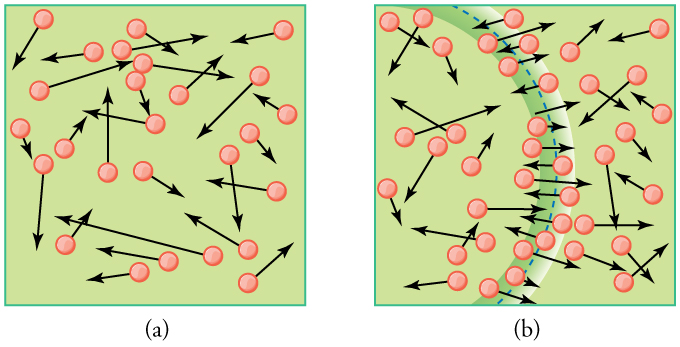| << Chapter < Page | Chapter >> Page > |
We can get the average kinetic energy of a molecule, , from the left-hand side of the equation by canceling and multiplying by 3/2. This calculation produces the result that the average kinetic energy of a molecule is directly related to absolute temperature.
The average translational kinetic energy of a molecule, , is called thermal energy . The equation is a molecular interpretation of temperature, and it has been found to be valid for gases and reasonably accurate in liquids and solids. It is another definition of temperature based on an expression of the molecular energy.
It is sometimes useful to rearrange , and solve for the average speed of molecules in a gas in terms of temperature,
where stands for root-mean-square (rms) speed.
(a) What is the average kinetic energy of a gas molecule at (room temperature)? (b) Find the rms speed of a nitrogen molecule at this temperature.
Strategy for (a)
The known in the equation for the average kinetic energy is the temperature.
Before substituting values into this equation, we must convert the given temperature to kelvins. This conversion gives
Solution for (a)
The temperature alone is sufficient to find the average translational kinetic energy. Substituting the temperature into the translational kinetic energy equation gives
Strategy for (b)
Finding the rms speed of a nitrogen molecule involves a straightforward calculation using the equation
but we must first find the mass of a nitrogen molecule. Using the molecular mass of nitrogen from the periodic table,
Solution for (b)
Substituting this mass and the value for into the equation for yields
Discussion
Note that the average kinetic energy of the molecule is independent of the type of molecule. The average translational kinetic energy depends only on absolute temperature. The kinetic energy is very small compared to macroscopic energies, so that we do not feel when an air molecule is hitting our skin. The rms velocity of the nitrogen molecule is surprisingly large. These large molecular velocities do not yield macroscopic movement of air, since the molecules move in all directions with equal likelihood. The mean free path (the distance a molecule can move on average between collisions) of molecules in air is very small, and so the molecules move rapidly but do not get very far in a second. The high value for rms speed is reflected in the speed of sound, however, which is about 340 m/s at room temperature. The faster the rms speed of air molecules, the faster that sound vibrations can be transferred through the air. The speed of sound increases with temperature and is greater in gases with small molecular masses, such as helium. (See [link] .)


Notification Switch
Would you like to follow the 'College physics' conversation and receive update notifications?